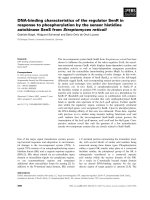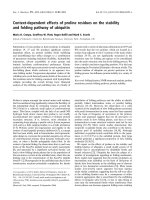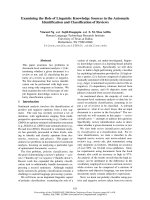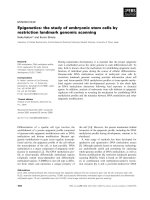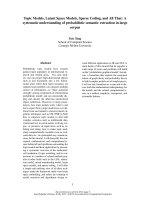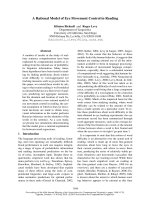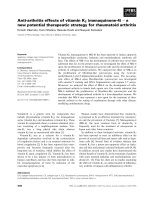Báo cáo khoa học: " No supra-additive effects of goserelin and radiotherapy on clonogenic survival of prostate carcinoma cells in vitro" ppsx
Bạn đang xem bản rút gọn của tài liệu. Xem và tải ngay bản đầy đủ của tài liệu tại đây (669.39 KB, 10 trang )
BioMed Central
Page 1 of 10
(page number not for citation purposes)
Radiation Oncology
Open Access
Research
No supra-additive effects of goserelin and radiotherapy on
clonogenic survival of prostate carcinoma cells in vitro
Robert M Hermann*
1
, Dag Schwarten
1
, Stefanie Fister
2
, Carsten Grundker
2
,
Margret Rave-Frank
1
, Mirko Nitsche
1
, Andrea Hille
1
, Paul Thelen
3
,
Heinz Schmidberger
4
and Hans Christiansen
1
Address:
1
Department of Radiotherapy, University hospital, Robert-Koch-Str. 40, 37075 Göttingen, Germany,
2
Department of Gynecology,
University hospital Göttingen, Robert-Koch-Str. 40, 37075 Göttingen, Germany,
3
Department of Urology, University hospital Göttingen, Robert-
Koch-Str. 40, 37075 Göttingen, Germany and
4
Department of Radiotherapy, University hospital, Langenbeckstr. 1, 55131 Mainz, Germany
Email: Robert M Hermann* - ; Dag Schwarten - ; Stefanie Fister - ;
Carsten Grundker - ; Margret Rave-Frank - ;
Mirko Nitsche - ; Andrea Hille - ; Paul Thelen - ;
Heinz Schmidberger - ; Hans Christiansen -
* Corresponding author
Abstract
Background: Oncological results of radiotherapy for locally advanced prostate cancer (PC) are
significantly improved by simultaneous application of LHRH analoga (e.g. goserelin). As 85% of PC
express LHRH receptors, we investigated the interaction of goserelin incubation with radiotherapy
under androgen-deprived conditions in vitro.
Methods: LNCaP and PC-3 cells were stained for LHRH receptors. Downstream the LHRH
receptor, changes in protein expression of c-fos, phosphorylated p38 and phosphorylated ERK1/2
were analyzed by means of Western blotting after incubation with goserelin and irradiation with 4
Gy. Both cell lines were incubated with different concentrations of goserelin in hormone-free
medium. 12 h later cells were irradiated (0 – 4 Gy) and after 12 h goserelin was withdrawn.
Endpoints were clonogenic survival and cell viability (12 h, 36 h and 60 h after irradiation).
Results: Both tested cell lines expressed LHRH-receptors. Changes in protein expression
demonstrated the functional activity of goserelin in the tested cell lines. Neither in LNCaP nor in
PC-3 any significant effects of additional goserelin incubation on clonogenic survival or cell viability
for all tested concentrations in comparison to radiation alone were seen.
Conclusion: The clinically observed increase in tumor control after combination of goserelin with
radiotherapy in PC cannot be attributed to an increase in radiosensitivity of PC cells by goserelin
in vitro.
Background
Luteinising hormone releasing hormone (LHRH) analoga
play an important role in the treatment of prostate carci-
noma (PC). As an alternative to surgical castration to sup-
press testosterone levels they are used in the palliative
treatment of advanced disease. Furthermore, in locally
Published: 26 August 2007
Radiation Oncology 2007, 2:31 doi:10.1186/1748-717X-2-31
Received: 24 May 2007
Accepted: 26 August 2007
This article is available from: />© 2007 Hermann et al; licensee BioMed Central Ltd.
This is an Open Access article distributed under the terms of the Creative Commons Attribution License ( />),
which permits unrestricted use, distribution, and reproduction in any medium, provided the original work is properly cited.
Radiation Oncology 2007, 2:31 />Page 2 of 10
(page number not for citation purposes)
advanced disease they improve overall survival when
given simultaneously to curative radiotherapy [1-3].
The mechanism of this enhancement of survival is still
obscure. Interestingly, several older trials that compared
radiotherapy with radiotherapy and surgical castration or
estrogen application did not show an improvement in
survival [4-7] except one [8]. This might be due to the
non-randomized study design of several trials and differ-
ent clinical endpoints.
In vitro studies that investigated oncological relevant end-
points like clonogenic survival could not demonstrate an
enhanced radiosensitivity of PC-cell lines by testosterone
ablation [9]. In vivo significant tumor regrowth delay was
seen after androgen ablation [10-14]. Two mechanisms
for the clinically observed improvement in overall sur-
vival after combination therapy were postulated: a) an
additive cell killing between androgen ablation and radi-
otherapy and b) reduced tumor regrowth kinetics after
androgen ablation [14]. Interestingly, about 85% of PC
express LHRH receptors [15]. The stimulation of these
receptors reduces via interferences with the epidermal
growth factor (EGF) receptor system the proliferation of
PC-cells in vitro and in vivo [16-18]. This is why we postu-
lated that the clinically observed improvement in overall
survival by the combination between LHRH agonists and
radiotherapy might be explained by an increased radio-
sensitivity of PC-cells after LHRH agonist exposure. To our
knowledge, in vitro studies testing this hypothesis have
not been published yet. LNCaP and PC-3 cells were
stained for LHRH receptor expression and analyzed for
effects of goserelin incubation on protein expression and
phosphorylation. Clonogenic cell survival and cell viabil-
ity were measured after incubation with different gosere-
lin concentrations and radiation doses.
Methods
Cell lines and cultures
The PC cell line LNCaP (ATCC nr. CRL1740) was chosen
as an androgen-responsive model of PC, the cell line PC-
3 (ATCC nr. CRL1435) as an androgen-independent sys-
tem.
Cells were cultured in Dulbecco's minimal essential
medium (DMEM, Invitrogen, nr. 41965-039, Paisley,
Scotland) supplemented with 2% glutamine, 1% sodium
pyruvate (all purchased from Sigma, Steinheim, Ger-
many), 1% penicillin and streptomycin (Biochrom, Ber-
lin, Germany]) and 10% inactivated fetal bovine serum
(Biochrom, nr. S0115) in 10% CO
2
atmosphere. To test
selectively the effects of goserelin without any other hor-
monal stimuli cells were grown in "hormone free
medium" (HFM): phenol red free DMEM (Sigma, nr.
D2902) supplemented with 4.5 g/l glucose (Sigma), 2%
glutamine, 1% sodium pyruvate, 1% penicillin + strepto-
mycin and 10% charcoal-stripped fetal bovine serum
(Biochrom, nr. S3113).
Staining for LHRH
Staining was done following a protocol as published pre-
viously [19]. 10.000 cells were seeded in each well of an
8-chamber slide. 24 h later the cells were washed in PBS,
incubated with 1 mol/l glycine for30 min, washed in PBST
(0.2% BSA, 0.1% Triton X-100 in PBS) for 2 × 15 min, and
treated in PBSTN (5% FBS in PBST) for 10 min. The first
antibody was a monoclonal mouse anti-human LHRH
receptor (clone A9E4; Research Diagnostics, Flanders,
New Jersey, USA), diluted 1:20 in PBSTN; the cells were
incubated therein at 4°C overnight. After three washes in
PBST, the cells were incubated with PBSTN for 30 min and
then treated with the Histostain SP kit for mouse primary
antibody (Zymed, San Francisco, California, USA) accord-
ing the manufacturer's instructions. Dako (Carpinteria,
California, USA) 3,3'-diaminobenzidine liquid substrate-
chromogen system was used as substrate. Controls were
performed by omission of the primary antibody.
Cell viability assay
Goserelin acetate was kindly provided from Astra-Zeneca
(Wedel, Germany). It was dissolved in H
2
O stock solu-
tion. Exponentially growing cells in maintenance cultures
were washed twice with PBS and incubated with HFM. 24
h later the cells were detached with trypsin/EDTA,
counted and diluted. 1000 cells were transferred into each
well of a 96-multiwell plate in HFM containing different
concentration of goserelin (0.001 – 10 µM or water con-
trol). 12 h later the plates were irradiated with 0 – 4 Gy
using a linear accelerator (Varian, Palo Alto, USA) with 6
MV (dose rate of 2.4 Gy/min). 12 h, 36 h and 60 h later
cell viability was determined using the CellTiter-BlueTM
assay (Promega, nr. G8081, Madison, USA) according the
manufacturer's instructions. The wells were incubated for
4 h with 20 µl of CTB-reagent, absorption was measured
in a photometer at 570 nm and 620 nm (reference). This
assay measures the metabolic capacity of cells using the
reduction of resazurin. In preliminary tests the absorb-
ance shift was proportional to the number of seeded
tumor cells.
Experiments were performed in triplicate and repeated at
least three times. The results were normalized to the spe-
cific irradiation controls (without goserelin) to demon-
strate synergistic effects between goserelin and irradiation.
Colony forming assay
Cell survival was evaluated using a standard colony-form-
ing assay. For LNCaP 1500 – 5000 cells were plated per 25
cm
2
flasks for low to high doses of radiation (0 Gy, 0.5, 1,
2, 4). Two days later the flasks were washed with PBS and
Radiation Oncology 2007, 2:31 />Page 3 of 10
(page number not for citation purposes)
cells were incubated with HFM to exclude any other than
the studied hormonal effects. After 24 h goserelin (0.01
µM and 10 µM) was added. 12 h later the flasks were irra-
diated with 6 MV. 12 h later the cells were washed and
incubated in normal culture DMEM without goserelin.
After more than 6 doublings (at least 15 days, change of
medium every 7 days) the experiments were stopped. The
cell layer was fixed with 70% ethanol and stained with
crystal violet. Scoring was done under a microscope. Col-
onies with more than 50 cells were counted as survivors.
As PC-3 cells proliferated much faster than LNCaP, the
strategy had to be adapted for this cell line. Washing and
incubation with HFM was done in the maintenance cul-
tures. After 24 h cells were detached using trypsin/EDTA,
counted, diluted and replated in 25 cm
2
flasks in FMH +
goserelin. 12 h later the flasks were irradiated. Experi-
ments were performed in quadruplicate and repeated at
least three times.
Protein extraction and Western Blot analysis
Cells were grown to 80% confluence in 75 cm
2
culture
flasks. The flasks were washed with PBS and cells were
incubated with HFM as described above. After 24 h 10 µM
goserelin was added and 12 h later the flasks were irradi-
ated with 4 Gy. 12 h later the cells were detached with 0.5
g trypsin as previously described [20]. The pellets were
washed twice with PBS and resuspended with CelLytic
buffer (Sigma) containing protease inhibitors (Sigma).
Equal amounts of protein per sample were used and
diluted to equal volumes with Laemmli buffer. The cell
lysates were separated on SDS-PAGE (15%, ProSieve 50
Gel Solution, Cambrex, Verviers, Belgium) under reduc-
ing conditions and transferred to nitrocellulose mem-
branes (HybonD-ECL, GE Healthcare Europe, Munich,
Germany). The nitrocellulose membranes were blocked
with 5% instant skimmed milk powder, spray-dried (Nat-
uraflor, Dietmannsried, Germany) in TBST [137 mmol/L
NaCl, 2.7 mmol/L KCl, 0.1% Tween 20, 25 mmol/L Tris-
HCl (pH 7.4)] for 1 h at room temperature, washed with
TBST, and then incubated at 4°C overnight with rabbit
anti-human polyclonal antibodies: anti-c-Fos: (Abcam,
Cambridge, UK, nr. 7963 [dilution 1:200 in TBST]), anti-
phospho ERK1/2 (Abcam, nr. 9101 [1:1000]), anti-phos-
pho p38 (Abcam, nr. 9211 [1:1000]), and anti-Actin
(Sigma, nr. A5060 [1:500]). Following washing the mem-
branes were incubated at room temperature with horse-
radish peroxidase-conjugated anti-rabbit IgG (GE
Healthcare Europe) at a 1:10,000 dilution in TBST for 1 h.
After washings, specifically bound antibody was detected
using the enhanced chemiluminescence kit (Millipore,
Schwalbach, Germany). The bands were analyzed using
the Kodak 1D image system (Kodak, New Haven, CT).
Statistical analysis
For descriptive statistics, the software package Kaleida-
Graph 3.5 (Synergy Software, Reading, USA) was used.
Means and standard deviations were calculated for each of
the data points; statistical comparison of the survival data
was done using the t-test and one-way ANOVA (Tukey
HSD for post hoc testing). P < 0.05 was considered statis-
tically significant. Survival curves, each referring to its spe-
cific control, were fitted to the data using the linear-
quadratic model. The results of the viability assays were
fitted with exponential functions, as this reflects best the
biological behaviour of exponentially growing cells.
Results
Staining of LHRH-receptors
The studied passages of both cell lines LNCaP und PC-3
showed a high expression of LHRH receptors. In figure 1
receptor expression is shown by a brown staining.
Changes in protein expression
To test the functional activity of goserelin in the investi-
gated cell lines, we analyzed protein expression and phos-
phorylation that are involved in functional signalling
downstream the LHRH receptor. These include p38, ERK
1/2 and c-fos [21], the results are shown in figure 2.
In LNCaP cells 24 h incubation with 10 µM goserelin or
irradiation with 4 Gy induced the expression of c-fos, but
the combination of both treatments did not further
increase the expression. In contrast, in PC-3 the expres-
sion of c-fos was not increased by goserelin incubation
and seemed to be slightly reduced by irradiation (when
compared to control).
Phosphorylated p38 was induced by goserelin incubation
and irradiation in LNCaP cells. In PC-3 cells, we found
more expression of this protein after incubation with gos-
erelin than after irradiation alone.
Goserelin incubation and irradiation induced the expres-
sion of phosphorylated ERK1/2 in LNCaP cells. In PC-3,
only the combination of irradiation and goserelin
increased the level of phosphorylated ERK1/2.
These results demonstrate that the incubation with goser-
elin led to alterations on the protein level. Goserelin incu-
bation was functionally active in our cell systems.
Cell viability
LNCaP
During the observation time (up to 60 h after irradiation)
the cells showed an exponential growth as expected (fig-
ure 3). Interestingly, the incubation with goserelin had no
significant influence on cell viability. Furthermore, addi-
tional irradiation showed no reduction of cell viability
Radiation Oncology 2007, 2:31 />Page 4 of 10
(page number not for citation purposes)
when compared to irradiated controls alone. When com-
paring 0 Gy goserelin control with 4 Gy and 10 µM goser-
elin only a trend of reduced cell viability was detectable
without statistical significance (figure 3-F, p = 0.23).
Noticeable, irradiation without goserelin proved to be of
minor activity regarding cell viability (figure 3-E). This
observation reflects the moderate induction of apoptosis
by irradiation in this cell line (see discussion) leading to
an insignificant reduction in the number of viable cells.
PC-3
Also in PC-3 cells an exponential growth kinetic was
expected and observed (figure 4). Like in LNCaP, neither
incubation with goserelin nor the combination of gosere-
lin and irradiation showed a significant reduction in cell
viability when compared to the particular controls.
Clonogenic survival
LNCaP
Incubation of LNCaP cells with goserelin in both tested
concentrations for 24 h during hormone withdrawal did
not show significant influence on clonogenic survival (fig-
ure 5).
Irradiation with 4 Gy alone reduced clonogenic survival
under 10% (figure 6). Additional incubation with gosere-
lin 12 h before and 12 h after irradiation did not further
decrease clonogenic survival. In this experimental setting
goserelin did not show any effects on the clonogenity of
LNCaP-cells.
PC-3
The same results were obtained in PC-3 cells. Neither
incubation with goserelin alone in different concentra-
tions (figure 7) nor additional incubation with goserelin
in combination with radiation therapy showed any signif-
icant influence on clonogenic cell survival when com-
pared to the particular controls (figure 8).
Discussion
We investigated the influence of incubation with goserelin
on the radiosensitivity of PC cells in vitro. This is of partic-
ular interest, as about 85% of PC express LHRH-receptors
[15]. Using immunohistochemistry we detected LHRH
expression in our cell lines, and in Western Blot analysis
we could show an effect of goserelin incubation on pro-
tein expression independent of irradiation effects.
Our experiments were done under androgen deprivation
(AD) (medium supplemented with charcoal-stripped fetal
bovine serum) to mimic the clinical situation. Goserelin
exposure of PC patients causes AD after about two weeks.
Under our experimental conditions we could not demon-
strate any significant influence of goserelin on radiosensi-
tivity of the tested PC cell lines. Therefore, our working
hypothesis was disproved: direct interaction of goserelin
with PC cells during irradiation does not seem to explain
the clinically observed increase of overall survival in
patients after combined therapy.
Recent studies investigated the effects of AD and radio-
therapy in PC cell lines in vitro [summarized in 9]. In
LNCaP cells AD led to growth delay. This delay could be
abolished by incubation with synthetic androgens. No
supraadditive effects on clonogenic survival were
observed, when AD was combined with irradiation. In
these experimental settings androgens were withdrawn in
varying protocols 3 to 5 days before irradiation. After irra-
diation the cells were subjected to "immediate plating" for
methodological reasons. This means that the monolayer
had to be trypsinized, counted and seated before colony
formation took place. In contrast, we tested much shorter
goserelin incubation times. This allowed us to investigate
the direct interaction between goserelin and radiotherapy.
We were not interested in long-term exposure of goserelin
before or after irradiation. Furthermore, as we avoided
Immunocytological staining of LHRH in LNCaP (A; B without primary antibody) and PC-3 (C; D without primary antibody)Figure 1
Immunocytological staining of LHRH in LNCaP (A; B
without primary antibody) and PC-3 (C; D without
primary antibody). Expression of the receptors reflects as
a brown staining. Both studied cell lines LNCaP und PC-3
showed expression of LHRH-receptors.
Radiation Oncology 2007, 2:31 />Page 5 of 10
(page number not for citation purposes)
"immediate plating", we could exclude possible errors
caused by this methodology.
Other studies investigated the interaction between AD
and radiotherapy in vivo. Subcutaneous tumors were
grown and AD was performed by means of surgical castra-
tion in male mice. Several studies demonstrated a signifi-
cant reduction of the TCD50 by the combination therapy
depending on the timing of AD [10-13].
Taken together in vivo and in vitro data support the
hypothesis, that androgen withdrawal during irradiation
increases clonogenic cell death in an additive manner [9].
Furthermore, the combination therapy leads to reduced
growth kinetics after irradiation. Both factors together
may explain the clinically observed survival benefit [9].
We chose to test goserelin concentrations between 0.01 –
10 µM. These concentrations showed significant effects on
proliferation of PC-cells, receptor binding and other end-
points in vitro [22,23]. In patients serum concentrations
of about 2 µM are reached after implantation of a gosere-
lin depot, with renal insufficiency up to 10 µM [24].
One proposed mechanism of biological activity of LHRH
in prostate carcinoma is that LHRH signalling involves
MAPK-kinases. Among others, LHRH receptors trigger
PLC to activate PKC. PKC activation limits EGFR tyrosine
kinase activity by phophorylating EGFR at threonine 654
[25].
We studied the effects of goserelin incubation on two
main MAPK-pathways (phos. p38 and phosphor ERK1/2)
and on c-fos 24 h after start of incubation, 12 h after irra-
diation (to reflect long term effects). In this setting, we
could demonstrate biological effects of goserelin on pro-
tein expression and phosphorylation. Goserelin incuba-
tion was functionally active in our cell systems.
The observation, that the incubation with goserelin
induced the c-fos expression in LNCaP cells is in contrast
to other reports. Dondi et al. incubated LNCaP cells with
10 µM LHRH agonist for 30 or 60 min, than added EGF to
the media during the last 30 min of incubation [26]. The
expression of c-fos was determined by Northern blot anal-
ysis. Under these conditions the LHRH agonist com-
pletely abrogated the EGF induced stimulation of c-fos
mRNA. On the other hand, in several human endome-
trial, ovarian and breast cancer cell lines an incubation of
quiescent cells for about 30 min with 1 µM triptorelin did
not alter c-fos mRNA expression in semiquantitative RT-
PCR [27]. These observations are in line with our results
in PC-3 cells. However, it is difficult to compare the results
of these studies, because they tested different incubation
Western Blot of c-fos, phosphorylated p38 and phosphorylated ERK1/2 after incubation with goserelin and irradiation with 4 GyFigure 2
Western Blot of c-fos, phosphorylated p38 and phosphorylated ERK1/2 after incubation with goserelin and
irradiation with 4 Gy. Cells were incubated with HFM for 24 h, than 10 µM goserelin was added. 12 h later the flasks were
irradiated with 4 Gy and after 12 h the cells were trypsinized. In LNCaP incubation with goserelin induced the expression of c-
fos more than irradiation alone. In PC-3 the expression of c-fos was not changed. Phosphorylated p38 was induced by goserelin
incubation and irradiation in LNCaP. In PC-3, there was a higher expression of this protein after incubation with goserelin than
after irradiation alone. Phosphorylated ERK1/2 was induced after goserelin incubation and irradiation in LNCaP, but not in PC-
3. These results show, that the incubation with goserelin was functionally active in the tested cell systems.
Radiation Oncology 2007, 2:31 />Page 6 of 10
(page number not for citation purposes)
Viability of LNCaP cells 12 h, 36 h, and 60 h after irradiation (t = 0 h) with 0 Gy (A), 1 Gy (B), 2 Gy (C) and 4 Gy (D) and incu-bation with different concentrations of goserelin (from 12 h before irradiation on)Figure 3
Viability of LNCaP cells 12 h, 36 h, and 60 h after irradiation (t = 0 h) with 0 Gy (A), 1 Gy (B), 2 Gy (C) and 4 Gy
(D) and incubation with different concentrations of goserelin (from 12 h before irradiation on). Experiments
were performed in triplicate and repeated at least three times. At the different time-points the cells were incubated with CTB-
reagent for 4 h, than absorption was measured at 570 nm and 620 nm. After blank-reduction radiation the results were nor-
malized to the specific irradiation controls (without goserelin). Results are expressed as measured absorbance. Error bars rep-
resent standard deviations. The effect of irradiation alone is shown in figure E. Incubation with goserelin had no significant
influence on cell viability. When comparing 0 Gy goserelin control with 4 Gy and 10 µM goserelin only a trend of reduced cell
viability is detectable without statistical significance (F; p = 0.23).
AB
0,5
1
1,5
2
2,5
3
10 20 30 40 50 60 70
LNCaP viability after 0 Gy irradiation
control
goserelin 0,01 µM
goserelin 0,1 µM
goserelin 1µM
goserelin 10µM
hours after RT
normed absorption (570nm, ref. 620nm)
0,5
1
1,5
2
2,5
3
10 20 30 40 50 60 70
LNCaP viability after 1 Gy irradiation
control
goserelin 0,01 µM
goserelin 0,1 µM
goserelin 1µM
goserelin 10µM
hours after RT
normed absorption (570nm, ref. 620nm)
0,5
1
1,5
2
2,5
3
10 20 30 40 50 60 70
LNCaP viability after 2 Gy irradiation
control
goserelin 0,01 µM
goserelin 0,1 µM
goserelin 1µM
goserelin 10µM
hours after RT
normed absorption (570nm, ref. 620nm)
C
0,5
1
1,5
2
2,5
3
10 20 30 40 50 60 70
LNCaP viability after 4 Gy irradiation
control
goserelin 0,01 µM
goserelin 0,1 µM
goserelin 1µM
goserelin 10µM
hours after RT
normed absorption (570nm, ref. 620nm)
D
0,5
1
1,5
2
2,5
3
10 20 30 40 50 60 70
LNCaP viability after irradiation without goserelin
0 Gy
1 Gy
2 Gy
4 Gy
hours after RT
normed absorption (570nm, ref. 620nm)
E
0,5
1
1,5
2
2,5
3
10 20 30 40 50 60 70
LNCaP viability 0Gy control vs 4Gy goserelin
control 0 Gy
goserelin 10µM 0 Gy
control 4 Gy
goserelin 10µM 4 Gy
hours after RT
normed absorption (570nm, ref. 620nm)
F
Radiation Oncology 2007, 2:31 />Page 7 of 10
(page number not for citation purposes)
Viability of PC-3 cells 12 h, 36 h, and 60 h after irradiation (t = 0 h) with 0 Gy (A), 1 Gy (B), 2 Gy (C) and 4 Gy (D) and incuba-tion with different concentrations of goserelin (from 12 h before irradiation on)Figure 4
Viability of PC-3 cells 12 h, 36 h, and 60 h after irradiation (t = 0 h) with 0 Gy (A), 1 Gy (B), 2 Gy (C) and 4 Gy
(D) and incubation with different concentrations of goserelin (from 12 h before irradiation on). Experiments
were performed in triplicate and repeated at least three times. At the different time-points the cells were incubated with CTB-
reagent for 4 h, than absorption was measured at 570 nm and 620 nm. After blank-reduction radiation the results were nor-
malized to the specific irradiation controls (without goserelin). Results are expressed as measured absorbance. Error bars rep-
resent standard deviations. The effect of irradiation alone is shown in figure E. In PC-3, neither incubation with goserelin nor
the combination of goserelin and irradiation showed a significant reduction in cell viability when compared to the particular
controls.
0,5
1
1,5
2
2,5
3
10 20 30 40 50 60 70
PC-3 viability after 0 Gy irradiation
control
goserelin 0,01 µM
goserelin 0,1 µM
goserelin 1µM
goserelin 10µM
hours after RT
normed absorption (570nm, ref. 620nm)
0,5
1
1,5
2
2,5
3
10 20 30 40 50 60 70
PC-3 viability after 1 Gy irradiation
control
goserelin 0,01 µM
goserelin 0,1 µM
goserelin 1µM
goserelin10µM
hours after RT
normed absorption (570nm, ref. 620nm)
0,5
1
1,5
2
2,5
3
10 20 30 40 50 60 70
PC-3 viability after 2 Gy irradiation
control
goserelin 0,01 µM
goserelin 0,1 µM
goserelin 1µM
goserelin 10µM
hours after RT
normed absorption (570nm, ref. 620nm)
0,5
1
1,5
2
2,5
3
10 20 30 40 50 60 70
PC-3 viability after 4 Gy irradiation
control
goserelin 0,01 µM
goserelin 0,1 µM
goserelin 1µM
goserelin 10µM
hours after RT
normed absorption (570nm, ref. 620nm)
0,5
1
1,5
2
2,5
3
10 20 30 40 50 60 70
PC-3 viability
0 Gy
1 Gy
2 Gy
4 Gy
normed absorption (570nm, ref. 620nm)
hours after RT
AB
DC
E
Radiation Oncology 2007, 2:31 />Page 8 of 10
(page number not for citation purposes)
Clonogenic survival of PC-3 cells after 24 h incubation with goserelin 0.01 µM and 10 µMFigure 7
Clonogenic survival of PC-3 cells after 24 h incuba-
tion with goserelin 0.01 µM and 10 µM. Colonies were
evaluated after 6 cell doublings (only colonies > 50 cells
counted). Survival was expressed relative to untreated con-
trols. Error bars represent standard errors. There was no
significant influence of 24 h goserelin incubation during hor-
monal withdrawal on clonogenic survival of PC-3 cells. A
concentration dependent effect was not seen.
0
0,2
0,4
0,6
0,8
1
1,2
1,4
normalized plating efficiency
control
goserelin 0,01 µM
goserelin 10 µM
Clonogenic survival of LNCaP cells after 24 h incubation with goserelin 0.01 µM and 10 µMFigure 5
Clonogenic survival of LNCaP cells after 24 h incuba-
tion with goserelin 0.01 µM and 10 µM. Colonies were
evaluated after 6 cell doublings (only colonies > 50 cells
counted). Survival was expressed relative to untreated con-
trols. Error bars represent standard errors. There was no
significant influence of 24 h goserelin incubation during hor-
monal withdrawal on clonogenic survival of LNCaP cells. A
concentration dependent effect was not seen.
0
0,2
0,4
0,6
0,8
1
1,2
1,4
normalized plating efficiency
control goserelin 0,01 µM
goserelin10 µM
Clonogenic survival of LNCaP cells after incubation with goserelin 0.01 µM and 10 µM 12 h before and after irradiation with single doses between 0 and 4 GyFigure 6
Clonogenic survival of LNCaP cells after incubation with gosere-
lin 0.01 µM and 10 µM 12 h before and after irradiation with sin-
gle doses between 0 and 4 Gy. Colonies were evaluated after 6 cell
doublings (only colonies > 50 cells counted). Survival was expressed rela-
tive to sham-irradiated controls. Experiments were performed in quadru-
plicate and repeated at least three times. Error bars represent standard
errors. Linear-quadratic equation was used for the control and the goser-
elin 10 µM curve, a polynominal equation for the goserelin 0.01 µM curve.
Incubation with hormones in different concentrations (dotted lines) did
not alter cell survival significantly when compared to untreated controls.
0,01
0,1
1
00,511,522,533,54
control
goserelin 0.01 µM
goserelin 10 µM
normalized plating efficiency
dose [Gy]
Clonogenic survival of PC-3 cells after incubation with goser-elin 0.01 µM and 10 µM 12 h before and after irradiation with single doses between 0 and 4 GyFigure 8
Clonogenic survival of PC-3 cells after incubation
with goserelin 0.01 µM and 10 µM 12 h before and
after irradiation with single doses between 0 and 4
Gy. Colonies were evaluated after 6 cell doublings (only col-
onies > 50 cells counted). Survival was expressed relative to
sham-irradiated controls. Experiments were performed in
quadruplicate and repeated at least three times. Linear-quad-
ratic equation was used for all curves. Error bars represent
standard errors. Incubation with hormones in different con-
centrations (dotted lines) did not alter cell survival signifi-
cantly when compared to untreated controls.
0,1
1
10
0 0,5 1 1,5 2 2,5 3 3,5 4
control
goserelin 0.01 µM
goserelin 10 µM
normalized plating efficiency
dose [Gy]
Radiation Oncology 2007, 2:31 />Page 9 of 10
(page number not for citation purposes)
times of LHRH analoga, investigated different cell systems
and analyzed different endpoints (e.g. RNA-expression vs.
protein expression).
Noticeable was the minor influence of irradiation and the
combination of goserelin incubation and irradiation on
cell viability. One limitation of this method was the meas-
urement of exponentially growing cultures. Minor inaccu-
racies in cell plating at the start of each assay aggravated
over time, resulting in substantial differences in cell num-
bers at the time of measuring cell viability. This led to
standard deviations of up to 40%. A further obstacle was,
that metabolic activity assays seldom reflect cell cytotoxic-
ity from RT in solid malignancies. We used this assay to
investigate for growth arrest and apoptosis induced by the
two treatment modalities. However, directly after irradia-
tion cell numbers will not be reduced in these solid tumor
cell lines. The induction of apoptosis has been investi-
gated in LNCaP and PC-3 cells grown in standard medium
by several groups. With different methodological
approaches only a minor induction of apoptosis was seen
24 h after irradiation with 4 – 5 Gy (< 5% more than in
sham-irradiated controls) [28-30]. One study showed
increased rates of apoptosis after irradiation of cells grown
in charcoal-stripped serum, but could not demonstrate
any dose dependence [9]. In fractionated experiments AD
did no further increase induction of apoptosis [12]. The
authors concluded that apoptosis did not play a major
part in tumor control in this experimental design.
Taken together, our cell viability data are easily explained
by published results of other studies.
Conclusion
We could not demonstrate any significant effects of goser-
elin on irradiated PC cell lines in vitro. The clinically
observed increase in tumor control after combination of
goserelin with radiotherapy in PC cannot be attributed to
an increase in radiosensitivity of PC cells by goserelin in
vitro. It is to be explained by the synergistic effects of AD
and irradiation.
Although studies on the combinatory effects of LHRH
receptor-antagonists (e.g. cetrurelix) and radiotherapy are
still missing, we suppose no detrimental effects on tumor
control, as the incubation with LHRH receptor-agonists
proved not to increase radiosensitivity of PC cell lines.
Competing interests
Potential conflicts of interest exist: Astra-Zeneca granted
20 mg of goserelin to support our study (value about
500,- €). R.M.H. received honoraria for lecturer activities
by Astra-Zeneca under 1000,- €. The authors assure that
the acquisition and interpretation of laboratory data were
not influenced by the donation and the honoraria.
Authors' contributions
RMH designed the study, coordinated the work and
drafted the manuscript
DS did the cytological work and helped with irradiation
tests
SF and CG designed the functional studies and performed
receptor analysis and the Western blots
MRF coordinated the work, interpreted the data and
helped drafting the manuscript
MN and AH did the irradiations and performed statistical
analysis
PT and HS participated in the study design and interpreta-
tion of the data
HC conceived the study, and participated in its design and
coordination and helped to draft the manuscript
All authors read and approved the final manuscript.
Acknowledgements
This study was supported by a grant of "Deutsche Krebshilfe" Nr. 106240
and by Astra-Zeneca (material donation)
References
1. Bolla M, Gonzalez D, Warde P, Dubois JB, Mirimanoff RO, Storme G,
Bernier J, Kuten A, Sternberg C, Gil T, Collette L, Pierart M:
Improved survival in patients with locally advanced prostate
cancer treated with radiotherapy and goserelin. N Eng J Med
1997, 337:295-300.
2. Bolla M, Collette L, Blank L, Warde P, Dubois JB, Mirimanoff RO,
Storme G, Bernier J, Kuten A, Sternberg C, Mattelaer J, Lopez Tore-
cilla J, Pfeffer JR, Lino Cutajar C, Zurlo A, Pierart M: Long-term
results with immediate androgen suppression and external
irradiation in patients with locally advanced prostate cancer
(an EORTC study). Lancet 2002, 360:103-106.
3. Pilepich MV, Winter K, John MJ, Mesic JB, Sause W, Rubin P, Lawton
C, Machtay M, Grignon D: Phase III radiation therapy oncology
group (RTOG) trial 86-10 of androgen deprivation adjuvant
to definitive radiotherapy in locally advanced carcinoma in
locally advanced carcinoma of the prostate. Int J Radiat Oncol
Biol Phys 2001, 50:1243-1252.
4. Van der Werf-Messing B, Sourek-Zikova V, Blonk DI: Localized
advanced carcinoma of the prostate: radiation therapy ver-
sus hormonal therapy. Int J Radiat Oncol Biol Phys 1976,
1:1043-1048.
5. Neglia WJ, Hussey DH, Johnson DE: Megavoltage radiation ther-
apy for carcinoma of the prostate. Int J Radiat Oncol Biol Phys
1977, 2:1123-1127.
6. Taylor WJ, Richardson RG, Hafermann MD: Radiation therapy for
localized prostate cancer. Cancer 1979, 43:1123-1127.
7. Fellows GJ, Clark PB, Beynon LL, Boreham J, Keen C, Parkinson MC,
Peto R, Webb JN: Treatment of advanced localised prostatic
cancer by orchiectomy, radiotherapy, or combined treat-
ment: a Medical Research Council Study. Br J Urol 1992,
70:304-309.
8. Granfors T, Modig H, Damber JE, Tomic R: Combined orchiec-
tomy and external radiotherapy versus radiotherapy alone
for nonmetastatic prostate cancer with or without pelvic
lymph node involvement: a prospective randomized trial. J
Urol 1998, 159:2030-2034.
Publish with BioMed Central and every
scientist can read your work free of charge
"BioMed Central will be the most significant development for
disseminating the results of biomedical researc h in our lifetime."
Sir Paul Nurse, Cancer Research UK
Your research papers will be:
available free of charge to the entire biomedical community
peer reviewed and published immediately upon acceptance
cited in PubMed and archived on PubMed Central
yours — you keep the copyright
Submit your manuscript here:
/>BioMedcentral
Radiation Oncology 2007, 2:31 />Page 10 of 10
(page number not for citation purposes)
9. Pollack A, Salem N, Ashoori F, Hachem P, Sangha M, von Eschenbach
AC, Meistrich ML: Lack of prostate cancer radiosensitization
by androgen deprivation. Int J Radiat Oncol Biol Phys 2001,
51:1002-1007.
10. Hara I, Miyake H, Yamada Y, Takechi Y, Hara S, Gotoh A, Fujisawa M,
Okada H, Arakawa S, Soejima T, Sugimura K, Kamidono S: Neoadju-
vant androgen withdrawal prior to external radiotherapy for
locally advanced adenocarcinoma of the prostate. Int J Urol
2002, 9:322-328.
11. Joon DL, Hasegawa M, Sikes C, Khoo VS, Terry NH, Zagars GK, Meis-
trich ML, Pollack A: Supra-additive apoptotic response of
R3327-G rat prostate tumors to androgen ablation and radi-
ation. Int J Radiat Oncol Biol Phys 1997, 38:1071-1077.
12. Pollack A, Ashoori F, Sikes C, Joon DL, von Eschenbach AC, Zagars
GK, Meistrich ML: The early supra-additive apoptotic response
of R3327-G prostate tumors to androgen ablation and radia-
tion is not sustained with multiple fractions. Int J Radiat Oncol
Biol Phys 1999, 46:153-158.
13. Granfors T, Tomic R, Bergh A, Rydh M, Löfroth PO, Widmark A:
After radiotherapy testosterone stimulation is unable to
increase growth in the Dunning R3327-PAP prostate
tumour. Urol Res 1999, 27:357-361.
14. Kaminski JM, Hanlon AL, Joon DL, Meistrich M, Hachem P, Pollack A:
Effect of sequencing of androgen deprivation and radiother-
apy on prostate cancer growth. Int J Radiat Oncol Biol Phys 2003,
57:24-28.
15. Halmos G, Arencibia JM, Schally AV, Davis R, Bostwick DG: High
incidence of receptors for luteinizing hormone-releasing
hormone (LHRH) and LHRH receptor gene expression in
human prostate cancers. J Urology 2000, 163:623-629.
16. Wells A, Souto J, Solava J, Kassis J, Bailey KJ, Turner T: Luteinizing
hormone-releasing hormone agonist limits DU-145 prostate
cancer growth by attenuating epidermal growth factor
receptor signalling. Clin Cancer Res 2002, 8:1251-1257.
17. Limonta P, Dondi D, Moretti RM, Maggi R, Motta M: Antiprolifera-
tive effects of luteinizing hormone-releasing hormone ago-
nists on the human prostatic cancer cell line LNCaP. J Clin
Endocrinol Metab 1992, 75:207-212.
18. Jungwirth A, Galvan G, Pinski J, Halmos G, Szepeshazi K, Cai RZ,
Groot K, Schally AV: Luteinizing Hormone-Releasing Hor-
mone antagonist cetrorelix (SB-75) and bombesin antago-
nist RC-3940-II inhibit the growth of androgen-independent
PC-3 prostate cancer in nude mice. Prostate 1997, 32:164-172.
19. Gründker C, Schlotawa L, Viereck V, Eicke N, Horst A, Kairies B,
Emons G: Antiproliferative effects of the GnRH antagonist
cetrorelix and of GnRH-II on human endometrial and ovar-
ian cancer cells are not mediated through the GnRH type I
receptor. Eur J Endocrinol 2004, 151:141-149.
20. Fister S, Gunthert AR, Emons G, Gründker C: Gonadotropin-
releasing hormone type II antagonists induce apoptotic cell
death in human endometrial and ovarian cancer cells in vitro
and in vivo. Cancer Res 2007, 67:1750-1756.
21. Dobkin-Bekman M, Naidich M, Pawson AJ, Millar RP, Seger R, Naor
Z: Activation of mitogen-activated protein kinase (MAPK) by
GnRH is cell-context dependent. Mol Cell Endocrin 2006,
252:184-190.
22. Dondi D, Limonta P, Moretti RM, Marelli MM, Garattini E, Motta M:
Antiproliferative effects of luteinizing hormone-releasing
hormone (LHRH) agonists on human androgen-independent
prostate cancer cell line DU 145: evidence for an autocrine-
inhibitory LHRH loop. Cancer Res 1994, 54:4091-4095.
23. Pagnini U, Florio S, Crispino L, Pagnini G, Colangelo D, Rocco D,
Pacilio C, Pacilio M, Macaluso M, Giordano A: Direct effect of a
gonadotropin-releasing hormone agonist on the growth of
canine mammary tumour cells. J Cell Biochem 2002, 85:470-481.
24. Nagayoshi J, Higashi T, Maruyama Y: Serum concentrations of
flutamide and goserelin in a prostate cancer patient with
obstructive nephropathy: a case report. Hinyokika Kiyo 1999,
45:543-546.
25. Wells A, Souto JC, Solava J, Kassis J, Bailey KJ, Turner T: Luteinizing
hormone-releasing hormone agonist limits DU-145 prostate
cancer growth by attenuating epidermal growth factor
receptor signaling. Clin Cancer Res 2002, 8:1251-1257.
26. Dondi D, Moretti RM, Marelli MM, Motta M, Limonta P: Growth fac-
tors in steroid-responsive prostatic tumor cells. Steroids 1996,
61:222-225.
27. Gründker C, Günthert AR, Hellriegel M, Emons G: Gonadotropin-
releasing hormone (GnRH) agonist triptorelin inhibits estra-
diol-induced serum response element (SRE) activation and
c-fos expression in human endometrial, ovarian and breast
cancer cells. Eur J Endocrinol 2004, 151:619-628.
28. Gottschalk AR, Doan A, Nakamura JL, Stokoe D, Haas-Kogan DA:
Inhibition of phosphatidylinositol-3-kinase causes increased
sensitivity to radiation through a PKB-dependent mecha-
nism. Int J Radiat Oncol Biol Phys 2005, 63:1221-1227.
29. Mu Z, Hachem P, Pollack A: Antisense Bcl-2 sensitizes prostate
cancer cells to radiation. Prostate 2005, 65:331-340.
30. Truman JP, Gueven N, Lavin M, Leibel S, Kolesnick R, Fuks Z, Haimo-
vitz-Friedman A: Down-regulation of ATM protein sensitizes
human prostate cancer cells to radiation-induced apoptosis.
J Biol Chem 2005, 280:23262-23272.
